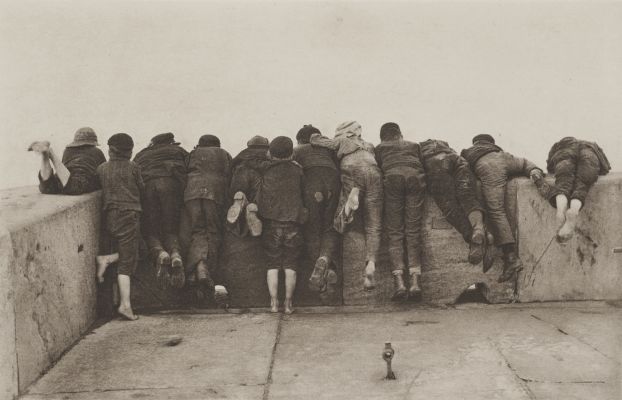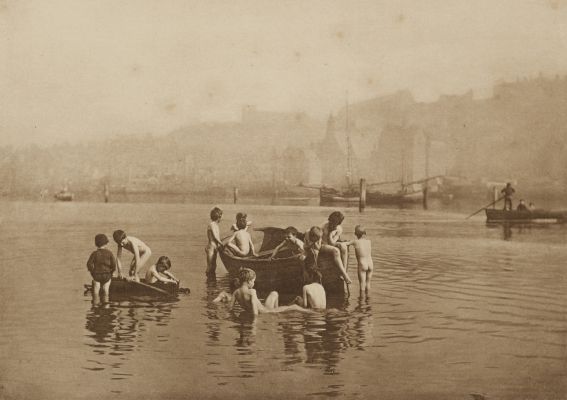
Title
Dinner TimeArtist
Sutcliffe, Frank Meadow (British, 1856-1937)Publication
Sun Artists Number 8Date
1891Process
PhotogravureAtelier
Walter L. Colls, LondonImage Size
12.2 x 17.5 cm
…there is to be specially noted that most subtle effect to the right of the picture of the moist atmosphere in the ravine cutting off the one upland from the other – this is an effect very common in moorland districts, excepting during an east wind, but it is one that is rarely satisfactorily painted, for the painter as a rule either under-estimates the degree of evanescence caused by the moist air in the ravine, and adopts variety of tone to cut off one upland from another, or he exaggerates it and makes too much of a feature of it. In this photograph the tone all through is perfect, and contains many lessons which artists may study with advantage; indeed, it is to the artist that photography must eventually have its highest value, for while such photographs as Mr. Sutcliffe’s, and such prints from them as Mr. Colls had made, are in themselves works of great beauty and pleasure, it is in the accurate knowledge of passing effects which they convey, that eventually their greatest Art value will be felt, and with the combined efforts of two such Art workers, we may hope for and hail with joy a vast series of pictures, undeniable in their beauty, and unchallengeable in their truthfulness, painted by that great painter of our universe – the Sun – who will, with unerring pencil of light, record for us, for all time, the glories he day by day reveals to us. [1] From descriptive text by Charles Noel Armfield highlighting the role that photogravure plays in achieving atmospheric effect.
Sun Artists was the first publication in England to represent ‘the artistic position of photography’. Published in eight parts between October 1889 and July 1891, each issue was devoted to the work of a single British photographer and illustrated by four hand-pulled photogravures. Particular care was taken by the publisher of Sun Artists to identify the individuals who prepared the photogravures for publication, all leading exponents of photogravure at the time. Mr Dawson of the Typographic Etching Company, himself an acclaimed photographer, made the etchings for Issue 1. Mr Cameron Swan of Messrs Annan and Swan made those for Issues 2, 3, and 4 while the etchings for Issues 5-8 were made by Mr W.L. Colls. [2]
These exceptional issues highlight those men and women who best express the period’s rich Pictorialist dialogue between painting and photography, the rise of the Secession Movement, and a turning point "in the ways photographs were made for the pages of books" [3] – namely in the photogravure process of "printing photographs from an etched copper plate" -as seen in these 32 superb hand-pulled gravures.
The photographers included are: J. Gale (essay by (George Davison); H.P. Robinson (essay by Andrew Pringle); J.B.B. Wellington (essay by Graham Balfour); Lydell Sawyer (essay by Rev. F.C. Lambert); Julia M. Cameron (essay by P.H. Emerson); B. Gay Wilkinson (essay by Rev. F.C. Lambert); F.W.H. Myers (essay by John Addington Symonds); and Frank Sutcliffe (essay by Charles N. Armfield). Sun Artists was issued in two states, a regular edition and an edition of 100 numbered copies on India proof paper, with the photogravures signed in pencil by the artists, with the exception of Julia Margaret Cameron who had already died.
References
[1] From descriptive text by Charles Noel Armfield highlighting the role that photogravure plays in achieving atmospheric effect.
[2] Hannavy John. 2008. Encyclopedia of Nineteenth-Century Photography. New York NY: Routledge.
[3] Goldschmidt Lucien Weston J Naef and Grolier Club. 1980. The Truthful Lens : A Survey of the Photographically Illustrated Book 1844-1914. 1st ed. New York: Grolier Club no 41
McCaully – History of Photography "Writing Photography’s History before Newhall " v 21 n 2 1997
Harker, Margaret. The Linked Ring: the Secession Movement in Photography in Britain, 1892-1910. London: Heinemann, 1979. Print.
Gernsheim, Helmut. The History of Photography: The Age of Collodion. London: Thames and Hudson, 1989. p.44
Weaver, Mike. British Photography in the Nineteenth Century: The Fine Art Tradition. Cambridge [United States: University Press, 1989. p. 157-8


